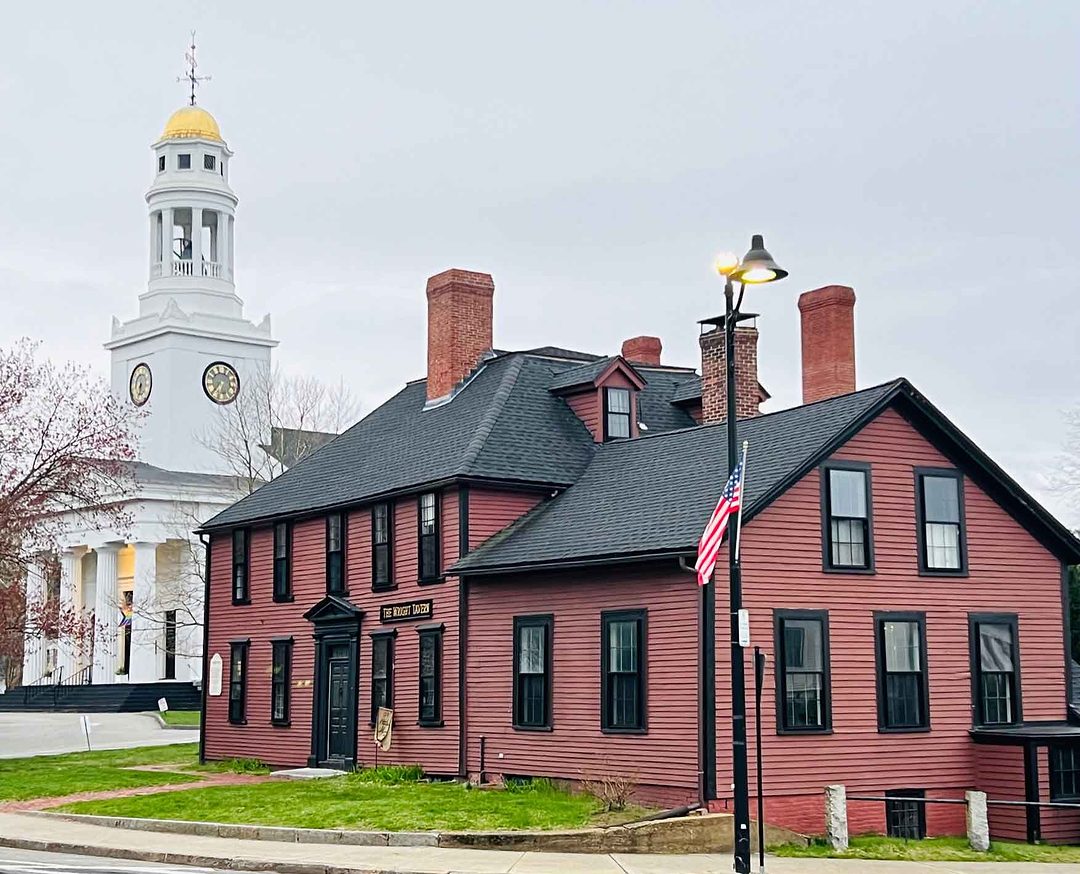 As the 250th Anniversary of the Battles of Lexington and Concord approaches, a witness house sits at the top of Concord’s Main Street, full of stories of rebels and traitors whose actions shaped the America we know today. It is the Wright Tavern, a red wood building with black shutters; one of the last standing colonial-era taverns from that fateful day of April 19, 1775.
As the 250th Anniversary of the Battles of Lexington and Concord approaches, a witness house sits at the top of Concord’s Main Street, full of stories of rebels and traitors whose actions shaped the America we know today. It is the Wright Tavern, a red wood building with black shutters; one of the last standing colonial-era taverns from that fateful day of April 19, 1775.
The tale of this tavern begins with a dangerous hole in the ground. On Concord’s founding in 1635, Reverend Peter Bulkeley, a Puritan minister who fled England to avoid religious persecution, owned property in Concord center including a grist mill in the area of today’s Concord Main Street Market. The mill was powered by the brook that runs through Concord center. As described in Concord historian George Tolman’s 1901 pamphlet “Wright’s Tavern,” millers required gravel to shore up the dam controlling the brook’s flow of water. The gravel was sourced from a pit dug on the edge of Bulkeley’s property next to the town meeting house. The gaping pit was a danger and an eyesore. Following Bulkeley’s death, the land was eventually gifted to the town with the grassy field in today’s Monument Square designated as a training ground for the local militia. The gravel pit was abandoned but the open hole remained until the town sold it in 1747 to Militia Captain and Town Selectman Ephraim Jones. Turning the pre-dug hole into a foundation, Jones quickly built a house on the site, opening it as an inn/tavern in competition with a nearby establishment owned by Thomas Munroe. Town selectmen who had once gathered over drinks at Munroe’s, moved their business to their fellow selectman Jones’ tavern and settled into decades of meetings in this building.
In 1751, Jones sold his establishment to Thomas Munroe and built another house just up the road (by Keyes Road and the Old South Burying Ground). After Jones’ death in 1756, his son, Ephraim Jones Jr., opened this building as another inn/tavern.

Wright Tavern
| Courtesy of Concord Public LibraryWhen Munroe died in 1766, his tavern was sold to Daniel Taylor. As Taylor continued the business, and Ephraim Jones Jr. did the same in his tavern a block away, the 1770s saw growing discontent with oppressive laws and taxes imposed by distant English Parliament.
By the spring of 1774, Parliament dismissed Massachusetts Governor Hutchinson and appointed Military Governor Thomas Gage in his place. A series of “Intolerable Acts” were imposed upon the colonies and further dissent boiled. In September 1774, Governor Gage ordered that, due to “recent tumultuous behavior,” he would not meet with the General Court of Massachusetts and their meeting should be postponed.
The colonists ignored Gage and decided to form their own government, free of English control. In October 1774, the first Massachusetts Provincial Congress met in Concord, assembling at the meeting house and spending time in Taylor’s tavern next door. The delegates held elections appointing colonists to positions in their new government, including James Warren, Esquire, as a Delegate to Rhode Island, and Doctor Benjamin Church as a member of the Committee of Safety. One of the committees formed was tasked to “consider what is necessary to be done now for the defence and safety of the province.” That committee’s decisions would result in military stores being stockpiled in Concord to supply a Continental Army.
A month later, King George III met with Parliament to address what His Majesty described as a “daring spirit of resistance…unhappily prevail[ing] in the Province of the Massachusetts Bay.” Parliament responded that they would “use every means in their power” to maintain His “Majesty’s supreme authority.”
Concord’s Patriot Minister William Emerson observed the result of Parliament’s resolution, writing that, on April 19, 1775, “between 1 & 2 [a.m.], we were alarmed by the ringing of the bell” in the meeting house next to Taylor’s tavern. Reverend Emerson, minutemen, and militia rushed to the town green outside of Taylor’s tavern which, for that year, was being run by Amos Wright, a hired barkeep. Here, Emerson and the townspeople learned that King’s “troops to the number of 800” were on the march from Boston to Concord.

Centennial Map of Concord 1775-1875 showing Wright and Jones’ Taverns Blaisdell, H. W. “Centennial map of Concord, 1775-1875.” Map. Boston: J.H. Bufford’s Sons Lith., [1875].
| Norman B. Leventhal Map & Education Center, https://collections.leventhalmap.org/search/commonwealth:js956j09k (accessaed January 05, 2025).Under command of Lieutenant Colonel Francis Smith and Major John Pitcairn, the column arrived in Concord and spread out to search the town for the rumored hidden military supplies while the Concord men took up a vantage point on a hill above the North Bridge. What happened next in Taylor’s and Jones’ taverns falls into the category of legends of Concord’s frantic efforts that morning to protect town valuables and secrets critical to the Patriot cause. It is commonly believed that Lieutenant Colonel Francis Smith set up a command post in Taylor’s tavern, while Major Pitcairn proceeded down Main Street to Jones’ establishment where a confrontation occurred and two cannons were discovered hidden in the nearby jail yard managed by Jones.
Perhaps looked out of by barkeep Amos Wright, the windows of Taylor’s tavern would have reflected flames as the British soldiers searching the town piled confiscated military supplies into a heap on the town green and burned them, the rising embers accidentally setting the town house roof ablaze and causing the militia on the hill above the bridge to believe the King’s troops were burning down Concord. The battle at the North Bridge occurred and British troops retreated in disarray to Concord Center, chaotically reforming their column near Taylor’s tavern before retreating to Boston.
As war began with England, tavern owner Daniel Taylor’s name appears in military records among other Concord men loyal to the Patriots’ cause, but not all once associated with Taylor’s tavern were as loyal as they seemed….
In October of 1775, James Warren wrote a concerning letter to John Adams, describing the interception of a letter from Doctor Benjamin Church. Written in code, Church’s letter was to Major Cane, a British Army officer and relative of General Thomas Gage, and shared details of the colonists’ military preparations. Wrote Warren, “The Doctor having formed an infamous connection, with an infamous hussey” gave the letter to her to deliver for him. The lanterns that hung in the North Church on the night of April 18, 1775, were brighter than this idea, for “the hussey” gave the letter to an ex-admirer to deliver for her, but he opened it instead and turned it over to General George Washington. Church had dug himself a hole that could not be transformed into any foundation to save himself. He was arrested by the Patriots but spared from execution, banished instead and put on a ship to the Caribbean. The ship, and all souls aboard, disappeared, likely lost at sea.
Like the disappearance of Dr. Benjamin Church, over time, taverns and inns that once stood in Concord disappeared. But the tavern built over the gravel pit at the top of Main Street survived. Perhaps for its association with barkeep Amos Wright on the infamous April 19, 1775, the tavern that Ephraim Jones built became known as the “Wright Tavern.” Today, the tavern is operated by the Wright Tavern Legacy Trust, which is working to preserve its history and open it to the public. Perhaps best described by James Warren’s words in his letter to John Adams, the Wright Tavern remains a witness to a “poison[ing] from New England [that] had got in use the Damned Absurd Word Liberty.”
The author extends thanks to Concord Library Special Collections and Beth van Duzer for research assistance.
**This article made possible with the support of the Wright Tavern Legacy Trust


